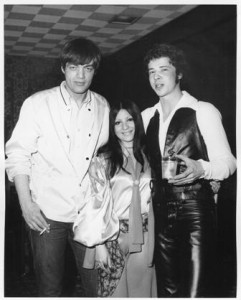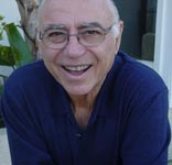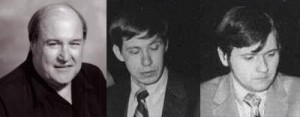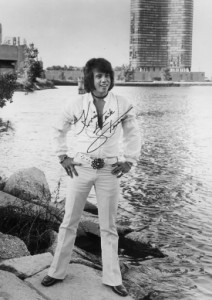
![]() As a youngin’ growing up in the 1940’s, I spent many evenings sitting on the floor of my grandparents living room in Ohio listening to those far off radio signals of which WLS was one. I could barely reach the buttons tuned to WLS, KDKA, WSM, KWKH & WLW and was delighted when grandpa allowed me to do so, but only with him nearby to make sure I didn’t “break the radio” as he would caution. To this day I recall WLS, WSM and KWKH were the favorites for their Hayride or Barn Dance music featuring the top country/western singers of the day, with WLW and KDKA known for news programming.
As a youngin’ growing up in the 1940’s, I spent many evenings sitting on the floor of my grandparents living room in Ohio listening to those far off radio signals of which WLS was one. I could barely reach the buttons tuned to WLS, KDKA, WSM, KWKH & WLW and was delighted when grandpa allowed me to do so, but only with him nearby to make sure I didn’t “break the radio” as he would caution. To this day I recall WLS, WSM and KWKH were the favorites for their Hayride or Barn Dance music featuring the top country/western singers of the day, with WLW and KDKA known for news programming.
This early influence of what was called “hillbilly” music would stay with me as a programmer, as I was always interested in providing airplay to recording artists who provided a simple understandable lyric with a haunting melody.
Imagine my excitement as a young man when I suddenly found myself being program director of KDKA’s competitor, KQV, who had its own early history starting in 1919, a year before KDKA’s. Having accepted the challenge to program WLS a few years later, I remember my drive from Pittsburgh to Chicago as being flooded with memories of those days as a small tike when I listened almost every Saturday night to the National Barn Dance on WLS. In my time at WLS, I was always aware of the historic significance of the station and the part it played in the careers of so many major celebrities over the years. I was sad to learn that so much of the historical artifacts pertaining to WLS’s history had been simply disposed of as so much garbage. As in KQV’s case, so it was with WLS. When ABC purchased the stations, the first move under new management was to “sweep with a new broom” any reminders of the past into the dumpster.
Moving to Chicago, I was intrigued as to why it was called “the windy city” when I found it no more gusty than other places I had lived. It took some digging until I discovered the tag originated back in the 1870’s when Chicago and Cincinnati were baseball rivals. The bragging of Chicago fans moved the Cincinnati Enquirer to begin referring to them as residents of “the windy city,” and the label stuck. Recalling my arrival at WLS in 1967. The signal was about half as hot as CFL’s and we sounded dull. The chief engineer told me it was my imagination but I had a friend in New York, Fred Zellner, head of all ABC radio engineering, who heard my story, caught a plane to Chicago and after three days had WLS sounding great AND with a new chief engineer who actually delivered my needs from that day on.
Ratings? Hell, I never looked at them and frankly had no idea why anyone in programming would…they were a sales tool.
Research? it came from common sense and my “gut.”
After about six weeks Gene Taylor, sales and engineering understood I had the backing of Hal Neal in New York….they simply got out of the way and allowed “it” to happen. That was the key….programming was first…the rest fell into place and enjoyed the ride. Upon my arrival at WLS, Gene Taylor piled a foot high research project on my desk that had been bought and paid for by ABC, advising the station on how to reverse the losses to WCFL.
Red faced with anger Gene was furious when I simply picked up the volumes of paper work and in placing it in my office closet said, “I don’t think I’ll be needing it.” After just two days of listening to WCFL it was obvious to me WLS could succeed simply by playing more music and modernizing its presentation. As WCFL jingles and features continued to limit the station’s ability to program hit music, WLS took advantage by cutting the clutter and programming more music. Art Roberts and Larry Lujack were very supportive but other WLS personalities were slow in accepting the changes I introduced. The WLS jingles, the Silver Dollar Survey and some of the on air talent I had inherited were soon gone as the Big 89 began its move to regain top spot in the Chicago ratings. My time as program director of WLS would be during one of the most tumultuous times in both the history of Chicago and the nation. The assassinations of Martin Luther King and Senator Robert Kennedy leading into the Democratic National Convention of 1968, the clash between protesters and police over the Vietnam War and a city run by the last of the big city bosses, Richard J. Daley, I was a witness to events that would remain etched in my mind for years to come. All news radio formats had yet to be introduced with WLS taking a major role in providing coverage of it all along with the music. Gene Taylor was not very pleased with my arrival. I had been placed in charge of programming against his wishes by ABC radio’s president, Hal Neal and given complete autonomy. As a manager who came from the programming side of the hall, obviously Gene was upset from day one, sitting in his office behind closed doors for most of the first six months I was there. When I did see him in the hallway, it was me who offered a greeting, Gene always frowned and seldom engaged me in any conversation. He didn’t bother to introduce me to the staff and I could feel the chill from the executive suite, including the sales manager.
Neal had suggested I “clean out the place” and start from scratch rebuilding the station. WLS had been badly bruised in the ratings by Ken Draper’s WCFL, the previous year. Hal Neal was a man who spoke what he felt and I was assured Gene Taylor would offer no interference to me. However, the office I was given was in the very back of the building, across from the men’s restroom. It was to be shared with the music librarian. The entire staff including on air talent had been hired by Gene and I could understand his concern for their continued employment. He had preceded my arrival apologizing for his inability to prevent my arrival, it was Hal Neal’s idea, not his. I attempted to give him respect due a V.P. general manager, but Gene wore his feelings on his shirt sleeve for all to see and it was clear he felt uncomfortable with me.
While everyone expected me to replace air staff, first blood did not come from there.
Gene had apparently transferred disrespect for me to the sales manager and within weeks of my arrival I ran into interference when instructing traffic to install a new program log with my format. After waiting for several days I inquired of the delay and the traffic department informed me the sales manager had declared, “Rook is in programming, not sales” and refused to allow a change in the program log. I had no doubt of my authority so I requested a meeting with Gene Taylor to make him aware of my need to format the program log. Walking into his office, Gene and the sales manager were waiting and questioned why I was interfering with the sales manager’s log. I held the log up and asked him to read what it said…he just smiled and told me to go back to my “hole in the back” and stop trying to create problems. Before leaving I held the log up and read the top line PROGRAM LOG, I said and I’m responsible for programming. Dismissing me with laughter, saying I should stick to programming and leave sales to them. Returning to “my hole in the back” I telephoned Hal Neal in New York. Neal was always easy for me to communicate with, a man of few words he often reminded it all began with product…not sales. “Who’s in the damn sales department you can work with John”. I suggested Bob Williams, with Hal asking me to repeat his last name. “Sit tight and I’ll take care of it”, he stated as he hung up. Catching the commute to my home in Des Plaines, my memory returned to Pittsburgh where my arrival had a similar experience.
When the phone rang at home that evening, I wasn’t surprised to hear Gene’s voice. It would be the one and only time he would telephone me at home, or in the office. “John”, his hesitant voice started, “I wish you hadn’t of called Hal over that silly log thing, now I have a real problem in sales”. “I’m sorry”, I said, “but I have a job to do and I don’t need to have hurdles placed in front of me”. I could hear him taking a long deep breath before saying, “Rook, you’re something else, always in such a damn hurry”. I added, “radio is immediacy you know Gene” as he hung up. Arriving at WLS the following morning a memo on my desk announced the previous sales manager was no longer employed at the station. It also announced a new sales manager, Bob Williams. The crowning touch came that afternoon when building maintenance came to my office to ask what I wanted moved to my new office, the former sales manager’s office in the executive area. It would be Neal’s way of making others aware of my authority. Changing the name of the WLS music list from “The Silver Dollar Survey” to the “WLS Hit Parade” didn’t go over all to well with Gene Taylor either, he was a DJ on WLS when the Silver Dollar Survey was first named and he saw no reason to change the name of it. I argued silver dollars were only used in Vegas slot machines and the term “Hit Parade” was well known from years of use on radio and TV.  Large portions of the once dominate WLS audience had moved to WCFL where Ken Draper had transformed his previous success in Cleveland. WLS was bland, boring and unbelievably had “No Respect” for the nations #1 song by Aretha Franklin. It wasn’t programmed but her previously unsuccessful Columbia releases were. On-the-air plugs of money making disc jockey hops would end and recording artist no longer received air play for free appearances. Some were outraged that I ended the practice of programming music that had not been previously approved by me. More often than not the persistence of Art Roberts paid off as he would badger me for days for permission to add songs by unknown artists. “Archie Bell & the Drells”, “Jeannie C. Riley” and “Zager & Evans” joined the one-hit-wonders that can thank Art Roberts for launching their one ride to the top of the charts.
Large portions of the once dominate WLS audience had moved to WCFL where Ken Draper had transformed his previous success in Cleveland. WLS was bland, boring and unbelievably had “No Respect” for the nations #1 song by Aretha Franklin. It wasn’t programmed but her previously unsuccessful Columbia releases were. On-the-air plugs of money making disc jockey hops would end and recording artist no longer received air play for free appearances. Some were outraged that I ended the practice of programming music that had not been previously approved by me. More often than not the persistence of Art Roberts paid off as he would badger me for days for permission to add songs by unknown artists. “Archie Bell & the Drells”, “Jeannie C. Riley” and “Zager & Evans” joined the one-hit-wonders that can thank Art Roberts for launching their one ride to the top of the charts.
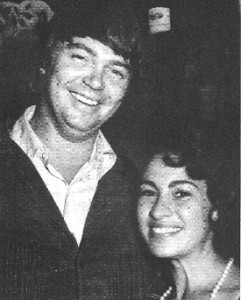
Bill & Betty
WLS in Chicago and KHJ in Los Angeles virtually dictated the nation’s music direction for several years. Often old friends Betty Breneman and Bill Drake tipped us on records that were hot with the RKO group of stations and we in turn supplied them with music information that was showing early success in the Midwest.
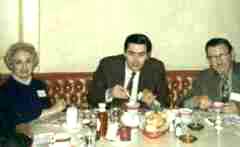
Janet Gavin, John Rook, Bill Gavin
Our mutual good friends Bill and Janet Gavin offered valuable insight on what was a hit and what was a hype in the years the recording industry enjoyed great profits selling a variety of music. FM was still a decade from being a factor in competition, AM radio was king. Not only was WLS #1 in Chicago with 3.2 million listeners each week, the station covered all of the east coast, the Midwest and the southern states. Music excitement was an important part of WLS programming. If WLS added a record for airplay, stations all over the nation followed suit.
While on a quick trip to Dallas to produce some new WLS jingles, I headed west to Los Angeles to visit superstar Petula Clark, hot off of her #1 hit song “Downtown”. Petula introduced me to her co-star the legendary dancer Fred Astaire.
Seeking to speed up the stations tempo I returned from Pams Productions in Dallas with at least a dozen short acappella’ s with an attention getting Alvino Rey guitar sting for punctuation. Jim West and Alan Box at Pam’s gave me the big, rich sound by adding more voices than normally sang on a “top forty” jingle package. I always insisted WLS was not a teeny bopper top forty station.
Not only was the on-air disc jockey talent, the news men, but the jingles also had to sound BIG…after all WLS was “the Big 89”. I could hardly wait to return to Chicago and hear them on the air. They were indeed a major change from the Anita Kerr jingle package long heard on WLS. What I didn’t know was again I would have to enlist the backing of the company president to get them on the air.
It was one of those times when the dark tan on Gene Taylor’s face turned a crimson red. Gene belittled my jingle producing efforts as “small market crap”, “a f-cking Joke” and refused to pay for them. He couldn’t envision jingles without a big orchestration. Accapella to him was “a practice run”, not a finished effort. I argued short jingles and more music was the key to defeating WCFL, where long jingles and uncontrolled disc jockey’s cut into the amount of music programmed. I insisted WLS disc jockeys would be able to establish a personality in a music driven format. Finally, Taylor’s, “their not going on this station” sent me to my office and another telephone call to Hal Neal.
Within ten minutes of that call, an angry Gene Taylor stuck his head in my office door saying, “do what you want to f-ck up this station, I don’t give a rats ass”. Gene never again questioned my programming decisions.
Andy Williams Henry Mancini Johnny Rivers
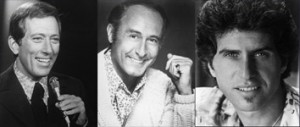
Meeting celebrities was usually pleasant, but meeting Andy Williams was a shock. Columbia records President Clive Davis probably was as surprised as I when shortly after my arrival at WLS, he introduced me to Andy. I was a huge Andy Williams fan beginning with his initial “Butterfly” in 1957 and continuing with his top rated weekly TV show throughout the 60’s. With Clive’s introduction, I extended my hand to shake and was stunned when Andy refused my handshake and blurted “big f-cking deal.” I immediately realized Andy was under the influence of something besides good manners, as a red faced Clive ushered me away. Henry Mancini had become the best known and most successful film composer in the world. I met him briefly a few years earlier in Pittsburgh while I was program director of KQV. WLS was one of the first “top 40” stations in the nation to provide Mancini’s “Theme from Romeo and Juliet” heavy airplay upon it’s release in the late 60’s. Upon his telephoning to say “thanks” for the exposure, I was surprised that he remembered my name from our previous meeting in Pittsburgh.
A few years later, my office in Hollywood was in the same building as Mancini’s, so we would meet for a sandwich where I enjoyed pulling stories out of my reluctant friend. My memories of Henry Mancini live on through the dozens of motion picture soundtracks. “Hank” was a classy, down to earth gentleman who left us much too soon.
My friend Bob Skaff was first to tell me about the Beatles, months before they would capture the world. At about the same time, Bob suggested I take time to visit a new hot spot on the Sunset Strip during one of my west coast trips. The Whisky A Go-Go was packed and it was easy to sense the excitement. A blonde Go-Go dancer named Goldie Hawn was featured in a cage hanging from the ceiling and Skaff was interested in my impression of the club’s main attraction…an unknown with no real track record as a recording artist. I didn’t remember his name but I sure was certain the guy had the stuff to become a hit recording artist. Skaff mentioned he was interested in “signing” the singer and given a positive reaction from me wanted to know if I’d program his new find on KQV. “Lou Adler has been shopping a live tape, but isn’t having much luck in getting it picked up”, said Skaff. Within a few days, Skaff sent me a tape of a previous Chuck Berry release called “Memphis”. I couldn’t wait to program it on KQV and almost immediately the career of Johnny Rivers took a climb to the top of the hit parade. Skaff was delighted when record stores in Pittsburgh ordered the record heavily and within days of their first order placed an order for 20,000 more records. “Pittsburgh is breaking this nationally” claimed Skaff, who was particularly pleased because he had gone against the advise of label president Al Bennett in signing Johnny Rivers.
Within a few months another Chuck Berry classic, “Maybellene”, was released, and following that a remake of a Harold Dorman song called “Mountain of Love” received the “go-go” treatment as “Johnny Rivers Live At The Whiskey A Go Go” became a #1 album. As I moved from KQV to WLS, I made certain Johnny Rivers continued to receive airplay for even bigger hits, “Poor Side of Town”, “Baby I Need Your Lovin'”and “Tracks of My Tears”. And a few years later as I moved California, I was pleased that Johnny would invite me to his home for Christmas celebrations. That unknown singer at the “Whiskey” had become a major part of the Hollywood music legend.
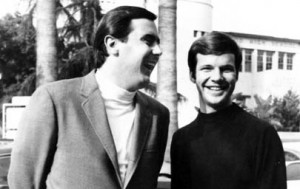
John & Bobby Vee 1968
It was in 1960 that I first met a young lad from North Dakota named Bobby Vee, in Denver promoting his “Devil or Angel” #1 hit. I had just arrived at KTLN with an air name of Johnny Rowe and Bobby was just beginning a string of hits for Liberty records. Here 8 years later when I was program director of WLS. 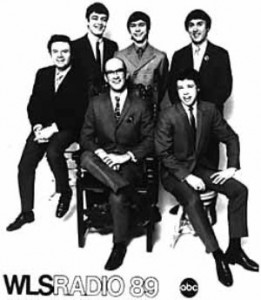
Larry LuJack and Art Roberts were common folks, with distinctive voices and an abundance of imagination. I instinctively knew they figured into my plans. Art was a most professional gentleman and everyone identified with his folksy personality. In all the years he was my friend I don’t ever remember him having a negative thing to say about anyone. Larry’s rebellious image and appearance gave need for me to think he must have some James Dean or Marlon Brando in him. As time would tell, both Art and Larry were radio originals and LuJack would become a radio franchise.
He never ventured from radio but I feel certain he could have made major contributions as an actor. Larry inspired and left his imprint on a young David Letterman.
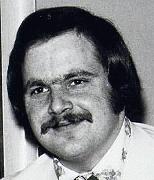 A lesser disc jockey named Jeff Christie challenged me to “dump LuJack and hire me”. I was correct when I advised him he “would never make it as a disc jockey”. He would spend some time away from radio before taking advantage of an industry that ended “the fairness doctrine” and allowed talk show hosts to rant as they wanted. Rush would borrow heavily from the Lujack style and become a talk radio star….but he never forgave me for not hiring him at WLS, where today his “talk” show is featured. Jeff Christie - Rush Limbaugh Like so many great radio talents, Lujack was shy in person, but a lion on the air.
A lesser disc jockey named Jeff Christie challenged me to “dump LuJack and hire me”. I was correct when I advised him he “would never make it as a disc jockey”. He would spend some time away from radio before taking advantage of an industry that ended “the fairness doctrine” and allowed talk show hosts to rant as they wanted. Rush would borrow heavily from the Lujack style and become a talk radio star….but he never forgave me for not hiring him at WLS, where today his “talk” show is featured. Jeff Christie - Rush Limbaugh Like so many great radio talents, Lujack was shy in person, but a lion on the air.
Once he understood that I was giving him room to develop, he began to reach outside the format box, pushing the envelope but always aiming to entertain…the entire family. Never anything that was vulgar or indecent, but with enough barb to capture attention. Always subject to ridicule as his boss, I actually received letters advising me what steps I should take for a more beneficial relationship with Larry. He named me “Big John the barn boss”, after the brutal prison guards in the Chicago jail. I became “everyone’s boss” with Larry smugly challenging, “just how smart could this guy be…coming from Pittsburgh?” Just as LuJack was beginning to feel his oats, Hal Neal called one day. Listening to Larry on the listen line in his New York office, Neal said, “he’s really putting you down and you don’t have to take that you know”. Explaining what I was trying to mold, Hal interrupted “Rook, you’re the boss”, as I nervously chuckled, “that’s right Hal”. Leaning back in my chair I took a deep breathe and hoped I was right … that LuJack’s sarcastic put down of city big shots would entertain and create attention before our luck ran out. Being program director of a cutting edge talent could cause some consternation, but we never received a complaint about his antics.
Always in good taste, Larry had a humorous side even when he was serious and the audience knew it. WLS had a large show place window where visitors could watch the stations personalities while they were on the air. Lujack hated the window, closing the drapes at the start of his show each day. Sales complained, saying clients visiting the station should be able to watch Larry perform. I understood Larry’s need to invent himself void of any distraction and the drapes stayed closed. One of those who regularly hoped to see Lujack at work was a young high school lad named Lee Abrams, who would in future times make a name for himself as a great radio programmer. Another who told me years later how he grew up listening to WLS and in fact would find his company hiring Larry Lujack many years later. His name is John Hogan, Clear Channel’s head honcho. Larry Lujack & Kris Erik Stevens with fan Larry Lujack was an important part of my radio career and continues my friend. We talk regularly, Larry living in New Mexico and me in Idaho.
Art Roberts could adlib a commercial better than anybody I knew. His conversational style delivered a sales pitch before most knew they had heard a commercial. A live implied endorsement was requested by clients willing to pay the extra fare. It was profitable for both the talent and the station, but Art always insisted he be allowed to visit or personally try a product before he would endorse it. Art also had an incredible “ear” for hearing the hits and I named him WLS music director. His excitement over a new artist would create more than one superstar, including Neal Diamond.
In the infancy of his singing career Neal Diamond was introduced to Art and me by Ilene Berns, widow of Bert Berns, founder of a fledgling Bang records. Art and WLS introduced Neil Diamond to the nation and soon he was signed to Universal and then Columbia.
My friendship with Russ Regan began in the early 1960’s and it has lasted through more than four decades as we continue to talk on a regular basis. Always a gentleman, Russ had an “ear” for hit artists and demonstrated it by making major contributions to the career’s of Elton John, Neil Diamond, Barry White, Olivia Newton-John, the Beach Boys and dozens of other giant music stars.
I always enjoyed the time I’d spend with Russ during those frequent trips to the west coast. While visiting him as president of Universal, he excitedly gave me a preview of a distant Neal Diamond release. Then while excusing him self to take a phone call, I “lifted” the disc and hurried back to Chicago to world premiere, “Holly Holy”. Russ called, “Rook, what are you doin’ to me?, he laughed. After a few days of fun we honored Russ’ request to hold off airplay until he could stock the stores. “You’re getting us orders from St. Louis, Denver, and throughout the south” said Russ. Ten days later we were allowed to continue airplay as Holly Holy became #1 overnight chart topper.
The bruised previous program director of WLS, Clark Weber, continued as the stations morning host, but not for long. While I was on a Montana vacation he gave his resignation to Gene Taylor. Reaching me via telephone Taylor seemed delighted at my inconvenience. “Clark’s turned in his resignation to go to CFL, so you getter get your ass back here, he leaves in two weeks” he said chuckling. What was so damn funny, I thought. Catching a plane from Billings, Montana I was back at WLS before the close of business on that same day, astonishing Taylor, who upon passing my office door did a double take seeing me behind my desk. Shaking his head in disbelief, he just shuffled away without saying a word. I enjoyed just letting everyone know I was never that far away that I couldn’t attend my duties. Of course one can only imagine how ClarkWeber reacted to my arrival at WLS. As the stations Program Director prior to my taking his job, Clark was at best “distant” to the major changes I made at WLS. Obviously, the powers that be in New York opened the door for me to do what ever was needed to reverse the station’s decline.
WLS could no longer win by default with its “dated” programming, as WCFL with Ken Draper at the helm had won the ratings race.Within a few weeks of my arrival the WLS of Clark Weber’s liking had become a totally different sounding station. My recognition of Lujacks talent didn’t set well with Weber, who had little appreciation of Larry and the personality I found to be a big plus for afternoon drive. Clark Weber and Ron Riley found it difficult to accept Lujack and I being the reason for Larry’s elevation in importance, was not well received either. Ron Riley would soon be gone, replaced by Chuck Buell and Kris Erik Stevens. Within a few months, WLS had regained its top rated position in Chicago and Ken Draper was shown the door at WCFL. Thus, it really came as no surprise that Clark Weber would be moving across the river to a short stay at CFL before in time landing at WIND.
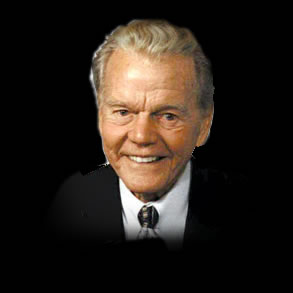 Paul Harvey ABC radio’s Chicago headquarters, including WLS was located at the corner of Wacker and Michigan in the Stone Container Building. Paul Harvey broadcast his daily news to the nation from the same building, providing me with the opportunity to have a few friendly chats with him. I always marveled at his always positive nature, never once did he express any negative thoughts. Anyone who ever heard him on the radio would find his phrasing, his delivery of the news, impossible to forget. There was only one Paul Harvey. In one of our conversations, he offered an explanation for his success. “Dare to be different” he said. It was advice I would never forget in programming from that day forward. After some thought I realized the great performers had unusual or unique delivery and on air talent, all I had to do was recognize and encourage them.
Paul Harvey ABC radio’s Chicago headquarters, including WLS was located at the corner of Wacker and Michigan in the Stone Container Building. Paul Harvey broadcast his daily news to the nation from the same building, providing me with the opportunity to have a few friendly chats with him. I always marveled at his always positive nature, never once did he express any negative thoughts. Anyone who ever heard him on the radio would find his phrasing, his delivery of the news, impossible to forget. There was only one Paul Harvey. In one of our conversations, he offered an explanation for his success. “Dare to be different” he said. It was advice I would never forget in programming from that day forward. After some thought I realized the great performers had unusual or unique delivery and on air talent, all I had to do was recognize and encourage them.
Always on the lookout for voices and personalities in what I term “a sea of sameness”, I was well aware of Kentucky’s “morning mayor”, Bill Bailey on WAKY in Louisville. Top rated year in and year out, I heard a tape of him when a competitor sent it to me months earlier hoping to get him hired out of the market. Searching for the reel of tape I had stashed away in a desk drawer, I couldn’t find it. I did remember from my initial listen that Bill Bailey as indeed very unusual.
It was after midnight when I checked into a Louisville hotel room, I’d started the morning in Montana, stopped in Chicago and was now setting my travel alarm for early wake up the next morning before sunrise, to audition Bill Bailey, unbeknown to him.
Arising in time to sip some coffee, I waited to hear if my new WLS morning man was here. I was up and into my first cup of coffee before hearing his opening greetings, a loveable distinctive character, Arthur Godfrey with the voice of Elmer Fudd. He was entertaining, believable, imaginative, and certainly one to be remembered. A lot like Art Roberts and Larry LuJack, they came from a similar cloth.
Early on I recognized Art Roberts, Larry LuJack and Jerry Kay were not like those who seemed transfixed on their individual stardom. However, I hesitated making any changes in the air names that had become well known to Chicagoans. Entering my third month as program director of WLS, Hal Neal came to visit. As he and Gene Taylor passed my office door, Neal paused for a minute, “Lunch?” he asked pointing to me. “Sure”, I answered, thinking I would be joining both of them for lunch. A short time later he returned alone signaling me to follow, “you won’t need a coat” he said as we headed to the London House in our WLS building. Settling in at our table Neal commenced, “I can tell you’ve got um playing more music, now if only they could sound like they enjoy it.” As I begun to offer an excuse for not yet making any on-air talent changes, Neal peered over the top of his cheater glasses interrupting, “Don’t give me that crap Rook, that’s why you got the job, now do it !
“Yes sir!” I replied, as we lunched watching an unknown singer from Australia named Helen Reddy.
Morton “Doc” Downey out of New Orleans was under consideration but Hal Neal was concerned he was “uncontrollable”. “Doc” would be one of the nations first “shock jocks”, but tame by recent standards. Neal insisted I look for “newer, younger talent” Age discrimination wasn’t even a term in those days. Mort and I talked from time to time over the years until again our paths would cross at KABC.
Chuck Buell came to my attention when he was a teenage disc jockey in Rapid City, South Dakota. He moved up to the coveted afternoon drive slot at KIMN – “the Denver Tiger” as it was known. The stations owner, Ken Palmer, was my good friend and largely responsible for my introduction to major market radio. Complaining Buell on WLS at night might lure some KIMN listeners, Palmer was also proud one of his talents was moving up to the big time. Being on the air at WLS was utopia for any young disc jockey. One of my initial hires in Chicago was Mike McCormick from KOIL in Omaha. Lyle Dean arrived to become “the Dean of Chicago newsmen”. Bob’s big voice was used on all of “the Big 89” tracks. Bob Benson, a shy but extremely qualified newsman was hired as News Director, propelling him to become VP of all ABC radio news. He too came from the same legendary Omaha station KOIL. Bob would go on to head up AP News nationally.
In my first year at WLS, my former boss, John Gibbs called looking for a new program director to replace Johnny Borders, who found Pittsburgh not as livable as his beloved Texas. I recommended McCormick, he would return to program WLS following my departure.
I hired Tom Bigby, who in the future would assist me at John Rook & Associates. Tom’s contribution to radio continued at WIP in Philly and KRLD in Dallas. Today he a valued programmer of CBS radio.
Kris Erik Stevens was passing through Chicago somewhere between jobs in Atlanta and San Francisco. I suggested he spend some time in Pittsburgh at KQV before coming to WLS. Arriving on Valentines Day, Lujack labeled him “a sweet kid, but does he have any talent?”.
It would signal a regular good natured scolding of the “kid” who just never seemed to satisfy Larry, but the “kid” would move on to Los Angeles, where Kris Erik Stevens is one of the nations top commercial voices. His charismatic personality and extraordinary voice characteristics are heard as the spokesman for prestigious national brands and clients worldwide.
Great talents leave an impression. Kris Erik Stevens leaves an impression.However, as I think back to those days in Chicago, I’ll always remember “the kid” that Lujack helped create.
Even with the Chicago Cubs in a playoff series, WLS topped WGN in the ratings. WCFL under Ken Draper ended and so did a challenge to WLS. With our lobby in the Stone Container Building filling with awards, WLS - “Station of the Year” and “Program Director of the Year”, I began to receive offers from numerous broadcast groups. Very shortly, youthful impatience and a job offer in California would lure me from WLS. My heart was in California but my job was in Chicago. After the first year any contact with Hal Neal slowed considerably.
WLS was a commanding shape delivering ratings and revenue well ahead of goals. I was slightly concerned when Rick Sklar told me Hal was deeply involved with the ABC fm division. Harkening back to my conversation with Hal prior to my arrival in Chicago, I expected any day to receive a call inviting me to get started with a new challenge programming ABC’s west coast fm. Imagine my shock upon hearing ABC’s fm division was instead handed to the assistant Program Director of WCFL, Allen Shaw. Having just defeated WCFL, I could not understand why my job…had been given to a competitor. I had lived up to my end of the agreement in reversing WLS’s slide, indeed the station was on top in Chicago even over rival WGN. I felt terribly betrayed by Hal Neal.
I seriously began to explore other options when my friend Bill Drake called asking if I’d like to join his efforts in California as president of his new Drake-Chenault syndication company. I had spent some time with Drake during trips to California and was very impressed with the job he and his right hand man Bill Warson had done for RKO radio. That group of stations nationally had everyone talking and certainly programming was in charge there, even more so than it was at ABC. My ticket to the west coast arrived and I took it. Rick Sklar at WABC telephoned suggesting I reconsider. “Hal could have something in mind for you, be patient.” I saw no need to reconsider and didn’t.
My friends in both the music and the radio industry surprised me with a giant send off in Chicago. Kris Erik Stevens brought the house down as he awarded me the actual studio phone deemed “the bat phone” I used to police my domain.
Within weeks of my departure a new WLS manager was announced as Gene Taylor moved to Cleveland to become manager of WIXY for a short period of time. I had recommended my old Denver boss, George Wilson, to replace me as program director of WLS. He was PD at the time at WOKY in nearby Milwaukee. Instead, the decision makers at ABC decided to return Mike McCormick, who had been production director of WLS for a short period of time before moving on to KQV as Program Director.
During the first year of my departure from WLS, several of the WLS on-air talent, including Art Roberts and Larry Lujack telephoned to advise me the they were having a difficult time taking “direction” from McCormick . One of the reasons I did not recommend McCormick as my replacement was because as the WLS production director he had not “meshed” all that well with neither Art or Larry, both vital ingredients to WLS’s success.
Thus, when I received an offer from WCFL’s GM, Lew Witz, I knew without much hesitation I could easily connivence Lujack to join me at WCFL. Within ten hours of returning to Chicago as WCFL’s consultant I had lunch with Larry Lujack and had hired him away from WLS where McCormick had moved him from afternoons to morning following my departure there. “Super Jock” Lujack became the quarterback for SuperCFL and within 90 days of his arrival WLS was no more. My job was done and I returned home to California. It wasn’t long before the manager and the program director of WLS were replaced.
In time with John Gehron as WLS’s PD and Marty Greenberg as the stations manager, Lujack would return to WLS and the Big 89 was once again top dog in Chicago ratings. Greenberg and Gehron were class guys, a great team that returned WLS to power in Chicago.
All Content on this Web site © 2008 John H. Rook All Rights Reserved

